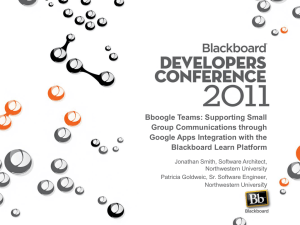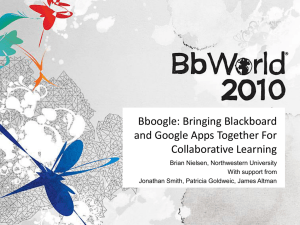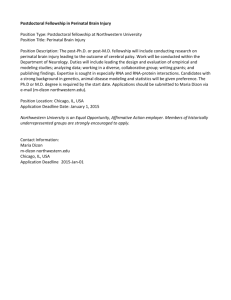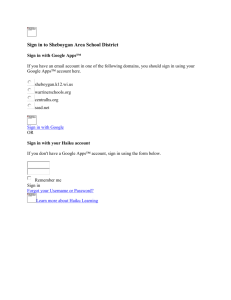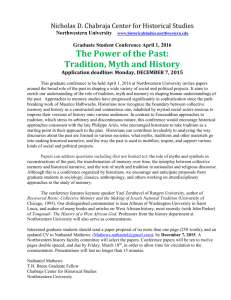BboogleTechnical
advertisement
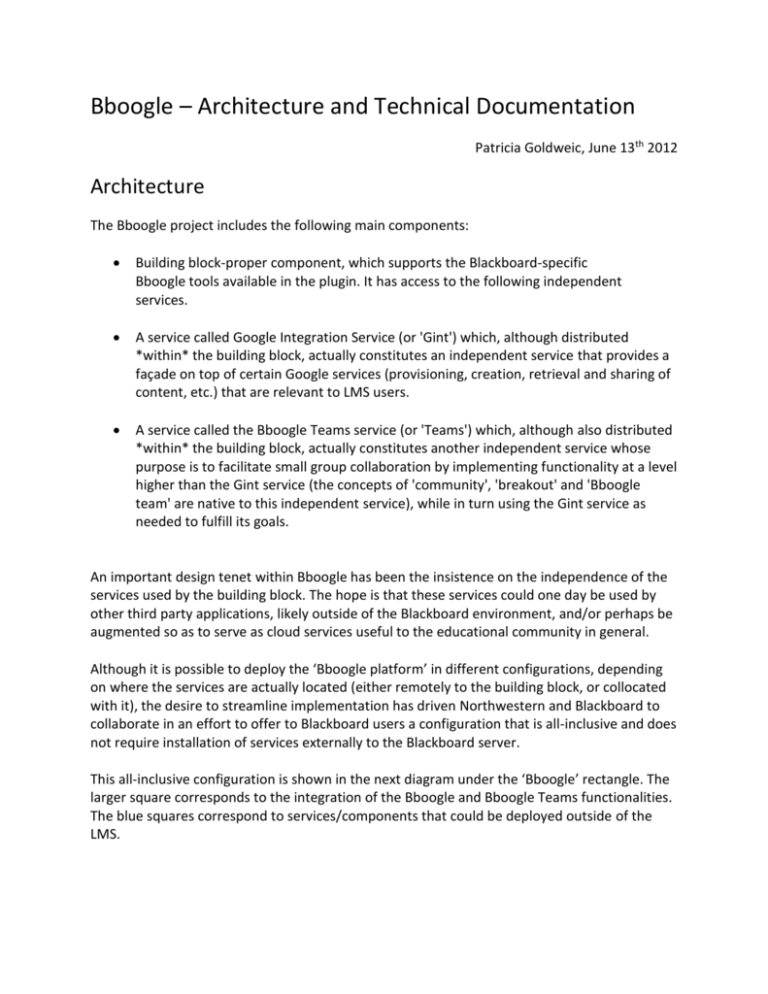
Bboogle – Architecture and Technical Documentation Patricia Goldweic, June 13th 2012 Architecture The Bboogle project includes the following main components: Building block-proper component, which supports the Blackboard-specific Bboogle tools available in the plugin. It has access to the following independent services. A service called Google Integration Service (or 'Gint') which, although distributed *within* the building block, actually constitutes an independent service that provides a façade on top of certain Google services (provisioning, creation, retrieval and sharing of content, etc.) that are relevant to LMS users. A service called the Bboogle Teams service (or 'Teams') which, although also distributed *within* the building block, actually constitutes another independent service whose purpose is to facilitate small group collaboration by implementing functionality at a level higher than the Gint service (the concepts of 'community', 'breakout' and 'Bboogle team' are native to this independent service), while in turn using the Gint service as needed to fulfill its goals. An important design tenet within Bboogle has been the insistence on the independence of the services used by the building block. The hope is that these services could one day be used by other third party applications, likely outside of the Blackboard environment, and/or perhaps be augmented so as to serve as cloud services useful to the educational community in general. Although it is possible to deploy the ‘Bboogle platform’ in different configurations, depending on where the services are actually located (either remotely to the building block, or collocated with it), the desire to streamline implementation has driven Northwestern and Blackboard to collaborate in an effort to offer to Blackboard users a configuration that is all-inclusive and does not require installation of services externally to the Blackboard server. This all-inclusive configuration is shown in the next diagram under the ‘Bboogle’ rectangle. The larger square corresponds to the integration of the Bboogle and Bboogle Teams functionalities. The blue squares correspond to services/components that could be deployed outside of the LMS. The Google Integration Service (‘Gint’) This service acts as a stateful façade on top of Google Apps services which are relevant to LMSs: provisioning of accounts and groups, retrieval, creation and sharing of Google documents, calendars and sites. It is in charge of the low level interaction with Google so that third party apps only need to concern themselves with their own business logic. The service was natively designed as a web service that accepts a number of requests (some http GET requests, but most are http POST requests) in specific, json-based formats. A utility class (edu.northwestern.at.bboogle.common.utils.CommunicationsUtil) is provided -within the common source- to access the Gint service remotely via http. Two main Gint Java servlets are in charge of receiving these requests when the Gint service is used in a standalone way: GintRequestServlet is in charge of receiving and dispatching all provisioning-related requests and requests that only modify the local Gint database. GintShareRequestServlet is in charge of receiving and dispatching all the content creation and content sharing requests. At a lower level than the servlets, and independently of whether Gint is used in standalone mode or as a client within a third party app, Gint requests are actually executed by one of the Gint request dispatchers: edu.northwestern.at.bboogle.gint.servlets.GintRequestDispatcher and edu.northwestern.at.bboogle.gint.servlets.GintShareRequestDispatcher, depending on whether the requests concern provisioning and database-related tasks, or content creation and/or content sharing. Gint Requests Requests can be seen as the native functional and processing unit within the Gint service. The edu.northwestern.at.bboogle.gint.data.GintRequest is the base class for all provisioning and database-related Gint requests, while the edu.northwestern.at.bboolge.gint.data.GintShareRequest is the base class for all content creation and content sharing requests. The two types of requests above have differing needs in terms of Google authentication, and the corresponding base classes above provide the necessary support so that individual request classes do not need to be concerned with the details of authentication. Provisioning-based requests used the Google client login method of authentication, although the adoption of 3-legged OAuth against a Google administrative account is in the roadmap (this is the most desirable scenario, in which no administrative credentials need to be stored by the application) . Content creation, retrieval and sharing requests use 2-legged OAuth to authenticate against the different Google services. Requests can be defined as either synchronous or asynchronous. An ‘offline’ field value of true in the edu.northwestern.at.bboogle.gint.data.GintBaseRequest class -parent of both of the above base request classes- indicates an asynchronous request that is to be executed in the background request execution thread). Synchronous requests are queued up in a blocking queue, which is managed by the edu.northwestern.at.bboogle.gint.servlets.RequestProcessingService class. All the requests dispatched within Gint get logged in the database in the GintTask table (see later section). Gint Scheduling The latest expanded Gint service (new as of version 3.0.0) supports the scheduling of a few types of requests: group membership, group membership deletions and group sharing, even though this behavior is not exposed yet within Bboogle. See a later section on the Bboogle Teams service to see how this functionality is being used there. The scheduling of Gint requests is done through specific (meta) types of requests whose job when executing is simply to create a Quartz job corresponding to one of the predefined job types (see package edu.northwestern.at.bboogle.gint.quartz, which contains the job definitions) , and which will in turn spawn a regular Gint request at the time the Quartz job is scheduled for. Quartz is currently used within the Gint service in non-persistent mode, so relevant Quartz jobs need to be loaded into memory when the Bboogle block gets initialized. Note that the only jobs that need to be (re) loaded are those whose schedule is in the future (the rest can be safely ignored, as they must already have been taken care of). Membership voting algorithm When the possibility exists that requests for membership in certain groups may overlap, or may arrive very close to each other (or simultaneously), there is a need to keep counters that represent the number of votes that were cast for or against a certain user’s membership in a certain group. Then a task is run periodically (edu.northwestern.at.bboogle.gint.quartz.GroupMembershipPeriodicRunJob) that inspects these counters in search for those records that indicate the need to actually run a group membership or group membership deletion task. While certain tools may require synchronous, immediate action (e.g. a dynamic link in Bboogle may require that the user who is clicking on a link be made a member of the corresponding team right then, if this is his/her first click, and he happened to join the Bb course *after* the Bboogle link was made by the instructor), other tools do not require such immediacy, and can simply execute ‘voting’ requests instead of direct group membership requests. In these cases, the counter corresponding to the relevant user/group pair is incremented or decremented as needed. There are a few configuration parameters which are directly related to the workings of this algorithm, as follows: membershipVotingEnabled is a Boolean parameter indicating whether the algorithm described above is in use (true by default) periodicTasksIntervalMinutes: an integer parameter representing the number of minutes between successive runs of the periodic job which implements the membership voting algorithm. The default value for this parameter is 10. designatedHostForPeriodicTasks: a string property holding the server hostname (prefix only) for the server designated to run the periodic job, when running in a clustered Tomcat configuration. In addition to the above, configurable parameters, the algorithm manages internally an additional parameter whose function is to keep track of the last time the periodic algorithm has run to completion: lastPeriodicJobRuntime, which represents a time in milliseconds. Persistence in the Gint service The Gint service uses the Java persistence framework (JPA) for persistence. The service keeps its state by persisting, among other things, the results of its successful interactions with Google services. In this way, it can avoid the re-execution of tasks that may be requested by third party applications (e.g. the dynamic links within the Bboogle building block send requests to Gint repeatedly). The following items are stored in Gint’s database: Google account and Google group provisioning records. These represent successful executions of the following types of request: o Account existence requests (class involved: edu.northwestern.at.bboogle.gint.persistence.GintAccount) o Group provisioning and existence requests (class involved: edu.northwestern.at.bboogle.gint.persistence.GintGroup) Group membership records. These represent successful executions of the following types of request: o Group membership requests (class involved: edu.northwestern.at.bboogle.gint.persistence.GintGroupMembership) Content ownership records. These represent a user’s ownership over a certain piece of content, and are created when third party applications (such as the Bboogle building block) request the creation of ‘links/bookmarks’. Request types associated with this type of record are: o Link creation requests (class involved: edu.northwestern.at.bboogle.gint.persistence.GintLink) Publication records for particular content items (in the form of ownership records) in particular LMS/third party app’s group entities (NOTE: these records concern publication within an LMS, or a third party app, and *not* sharing operations within Google Apps). Request types associated with this type of record are: o Link creation requests (class involved: edu.northwestern.at.bboogle.gint.persistence.GintPublication) Sharing records for particular publication records (NOTE: these represent actual Google Apps sharing requests). Represent successful executions of the following types of request: o Group sharing requests (class involved: edu.northwestern.at.bboogle.gint.persistence.GintShareRecords) Mapping records that associate a third party user id to a Google Apps user id. Request types associated with these records are: o Id mapping retrieval requests o Id mapping saving requests (class involved: edu.northwestern.at.bboogle.gint.persistence.IdMappingRecord) Gint request execution records. These represent execution records of individual Gint requests. (class involved: edu.northwestern.at.bboogle.gint.persistence.GintTask) Scheduled Gint request records. These represent Gint requests that have been scheduled to execute at some point in the future. They also record execution information. (class involved: edu.northwestern.at.bboogle.gint.persistence.GintScheduledTask) Group membership votes (counters). These records represent outstanding votes against/for the membership of a particular user in a particular group. When the periodic task runs as part of the group membership voting algorithm (see section above), it queries the database to find those counters that should trigger either a group membership or a group membership deletion request. A counter is considered to be in such state when o It has been modified since the last run of the periodic task o It has a different ‘sign’ than the current group membership record for the given user/pair. That is, the counter may have a positive sign, but no group membership record exists for the corresponding user/pair. Or, the counter has a negative sign, and there *exists* a group membership record for the user/pair. In the first case scenario, a group membership request should be executed. In the second scenario, a group membership deletion request should be executed instead. These records are represented by the class: edu.northwestern.at.bboogle.gint.persistence.GintGroupMembershipVotes Most of the persistence-related functionality is implemented by the edu.northwestern.at.bboogle.gint.PersistenceManager class, a singleton persistence service within the Gint service. Using Gint as a client Local vs. Remote Clients Since version 2.1.0.0, any third party application (e.g. Blackboard, for the case of the Bboogle building block) can use the Gint service as a client in either remote or local modes. In a remote implementation, the third party client communicates to the remote Gint service via http (as the original Bboogle did), while a local implementation counts on a Gint service that is collocated with the client application. Facades Within the Gint component, a special façade is available (since version 2.1.0Alpha) for Javabased third-party applications that want to use the Gint service as a client: edu.northwestern.at.bboogle.gint.client.GintServiceInterface. Prior to this version of Bboogle, only the building block component included such type of façade onto Google Integration services: edu.northwestern.at.bboogle.bb.services.GoogleAppsIntegrationInterface, although note that it is augmented with Blackboard business logic. The Gint component now also includes a couple of implementations for the new GintServiceInterface described above, corresponding to local and remote modes of access to Gint (edu.northwestern.at.bboogle.gint.client.GintServiceRemote and edu.northwestern.at.bboogle.gint.client.local.GintServiceLocal). In a similar fashion, the building block component has included (since 2.0.0) a couple of implementations for the GoogleAppsIntegrationInterface which also correspond to local and remote modes of access to Gint (edu.northwestern.at.bboogle.bb.services.GoogleAppsIntegrationLocalService and edu.northwestern.at.bboogle.bb.services.GoogleAppsIntegrationRemoteService ). Note that the GoogleAppsIntegrationInterface (sometimes called GAPS for brevity) is essentially an augmented GintServiceInterface which also has access to the Blackboard business logic. If the goal becomes to streamline the code, one could greatly simplify the classes implementing GoogleAppsIntegrationInterface so that they start delegating (most of the time) execution to a corresponding GintServiceInterface implementation instance. Configuration When using Gint as a local client (from an application other than the Bboogle building block), one needs to include a configuration-specific listener within the container web application: edu.northwestern.at.bboogle.gint.client.local.GintContextListener. This class takes care of performing the required service initialization. The distribution includes a set of simple sample web applications that use Gint as a client (‘sample-gint-client-apps’ folder). Please check these out before attempting to exercise this functionality. GintServiceInterface sample methods: public void ensureAccount(String accountID, String givenName, String familyName, String email) throws IOException: ensures that a Google account exists for a given person, creating it if necessary public String ensureGroupMembership(String groupId, String memberId, String groupRole) throws IOException: ensures that a given person is a member of the given group in the given role (sends Google a membership request unless the membership is already stored in Gint’s database) public String scheduleGroupMembership(String groupId, String memberId, Date when, String userid, String externalID): schedules the execution of a group membership request for some time in the future public void refreshProvisioningService(PropertiesFile config, String userid, String externalID): refreshes the provisioning service instance with possibly new configuration details. (this method is new in Gint 3.0.0.0) GoogleAppsIntegrationInterface sample methods: In addition to the above methods, consider: public String obtainGoogleID(String userBatchUid): retrieve the Google id mapped to the given Blackboard user batch uid public RosterData retrieveRosterData(String userBatchUid, String courseBatchUid): retrieves the Blackboard roster data for the given course and user. Gint Java Packages: edu.northwestern.at.bboogle.gint.servlets: contains the two servlets described earlier in this document (GintRequestServlet and GintShareRequestServlet), the request dispatchers, and the classes that support the queuing of requests edu.northwestern.at.bboogle.gint.data: contains *all* the requests supported within the Gint service. As long as no new authentication mode is required, adding a new request class will effectively augment the functionality of the Gint service. edu.northwestern.at.bboogle.gint.data.gservices: contains a series of wrappers on top of Google services, which act as a higher level Google service façade accessible to the Gint request classes. edu.northwestern.at.bboogle.gint.persistence: defines all the Gint persistent classes and Gint’s JPA-based persistence service. edu.northwestern.at.bboogle.gint.quartz: defines a series of Quartz jobs in charge of spawning particular types of Gint requests when they get executed. It also includes the periodic job that implements the membership voting algorithm. edu.northwestern.at.bboogle.gint.utilties: utilities used by Gint request classes edu.northwestern.at.bboogle.gint.client: defines the Gint client libraries (that is, libraries that support the use of Gint as a client, either remotely or locally. The sub package edu.northwestern.at.bboogle.gint.client.local implements the logic required in case the thirdparty app and the Gint service are collocated in the same web application. edu.northwestern.at.bboogle.gint.samples: defines sample code for applications that act as Gint clients, both remotely and locally (the sub package edu.northwestern.at.bboogle.gint.samples.local handles the case in which the third party app uses the edu.northwestern.at.bboogle.gint.client.local package to access the Gint service). The Bboogle Teams service (‘Teams’) This service acts as another independent, stateful high level façade on top of Google Apps services which are relevant to LMSs or third party apps in support of small group collaboration. The Bboogle Teams service defines the concept of a community (a group or cohort of Google Apps users), a breakout (a community’s partition of users into a set of disjoint groups/teams that is only valid within a given time interval), and a Bboogle team (a group construct backed by a Google Apps group, with associated Google Apps content – a Google site, a calendar, and a documents collection- that is shared with the whole team). Third party applications using the Bboogle Teams service as a client (e.g. the Bboogle building block), only need to interact with the Bboogle Teams service via a high level API that is far removed from the details involved in the corresponding Google interactions. The Bboogle Teams service was natively designed as a set of JAX-RS-based restful web services supporting the following operations: Creation, retrieval and update of communities Definition and update of time-restricted breakouts Definition and update of breakout memberships, representing the particular team assignments within a given breakout. NOTE: this is a level removed from the Gint membership records stored within the Gint service. The Team’s service breakout memberships are higher level definitions that only end up spawning Gint membership records when their associated breakouts become valid. Storage of mappings between third party group entity constructs and the corresponding Bboogle Teams concepts (e.g. when used by the Bboogle building block, it stores mappings of Blackboard group sets to Bboogle Teams breakouts, Blackboard groups to Bboogle Teams, and Blackboard courses to Bboogle Teams communities) Synchronization of third party group set entities with Bboogle Teams breakouts (whereby the group assignments of the third party application determine the team assignments within the corresponding Bboogle breakout). Restful services included in Bboogle Teams: The Community service (handles creation, retrieval and update of community objects). Implemented by the edu.northwestern.at.teams.restful.TeamsCommunityService class. The Breakout service (handles creation, retrieval and update of breakout objects). Implemented by the edu.northwestern.at.teams.restful.TeamsBreakoutService class. The Breakout Membership service (handles definition and update of breakout membership objects). Implemented by the edu.northwestern.at.teams.restful.TeamsBreakoutMembershipService class. The Team service (handles creation and update of team objects). Implemented by the edu.northwestern.at.teams.restful.TeamsTeamService class. The Person service (handles creation and update of Person objects, which represent the valid user objects within Bboogle Teams). Implemented by the edu.northwestern.at.teams.restful.TeamsPersonService class. Other, non-native Teams services were created during development for convenience: The CMS service (handles mappings between CMS or other third-party app group entities and the Bboogle Team entities; can also cache CMS/third party app roster information). Implemented by the edu.northwestern.at.teams.restful.TeamsCMSService class. A Teams ‘Gint’ service was added initially for convenience; not meant to be used by third party apps that have direct access to the Gint service, as it in fact is a small ‘backdoor’ through Teams into the Gint service underneath it. Implemented by the edu.northwestern.at.teams.restful.TeamsGintService class. The class edu.northwestern.at.teams.restful.TeamsRestfulService serves as a base class for all the classes that implement the native services above. Bboogle Teams requests and execution Although the Bboogle Teams service was designed natively as a set of JAX-RS-based restful web services, there is also a request-level library built on top of the restful service classes. This is provided in the package: edu.northwestern.at.teams.library, which defines Teams ‘request’ classes that correspond to all the methods supported by the restful services (note the functional similarity between the edu.northwestern.at.teams.library and edu.northwesternt.at.bboogle.gint.data packages –this last one defining the request library for the Gint service). The edu.northwestern.at.teams.library.TeamsRequest class is the base class for all the request classes within the Teams service, while the edu.northwestern.at.teams.library.TeamsResponse class is used to represent the responses (results) returned from the execution of Teams’ request classes. Teams’ requests can be synchronous and asynchronous (an ‘offline’ field value of true in the TeamsRequest class indicates an asynchronous request). Synchronous requests are executed in real time, while asynchronous requests are queued up in a blocking queue, which is in turn managed by the edu.northwestern.at.teams.servlets.TeamsRequestProcessingService class within the background thread class: edu.northwestern.at.teams.servlets.TeamsRequestProcessorThread. Because the Teams service was natively designed as a set of restful web services, the individual request classes (built on top) are all pretty shallow: they simply delegate processing to the class that implements the corresponding restful web service. Persistence in the Bboogle Teams service Similarly to the Gint service, the Bboogle Teams service uses the Java Persistence framework (JPA) for persistence. The Teams database stores the entities which are native to the Teams service: Community objects (edu.northwestern.at.teams.persistence.Community) Person objects (edu.northwestern.at.teams.persistence.Person) Breakout objects (edu.northwestern.at.teams.persistence.Breakout) Team objects (edu.northwestern.at.teams.persistence.Team) Breakout Membership objects (edu.northwestern.at.teams.persistence.BreakoutMembership) Relationships among the above object types (e.g. a relationship exists between Communities and the Person instances who owned them, between Communities and Team instances associated with them, between Communities and Breakout instances associated with them, etc. These relationships are defined by fields within the above Java classes) Mappings between third-party group entities and the above Bboogle Teams entities (three mapping tables are being stored: entities that map to Bboogle Teams communities, entities that map to Bboogle Teams breakouts, and entities that map to Bboogle Teams teams). See the classes edu.northwestern.at.teams.persistence.CommunityIdMapping, edu.northwestern.at.teams.persistence.TeamIdMapping, and edu.northwestern.at.teams.BreakoutIdMapping). The entities above are persisted to the database as soon as they are created due to requests posted to the Teams service. Note that this is a level removed from the Google Apps services that eventually get involved (by the Gint service) during the execution of Teams service requests. Example: when an instructor clicks for the first time the Bboogle Teams control panel tool within a course, a community object is created for this course. This generates a synchronous request to the Gint service to create a corresponding Google Apps group for this course’s community. Consider another example involving the use of the Bboogle Teams synchronization tool for the first time with a particular Bb group set: when an instructor submits a form in this tool, a set of team objects are created by the Team service. This in turn spawns several (asynchronous) Gint requests (by the Teams service itself) aimed at creating the associated Google site, calendar, documents collection, share all this content with the corresponding team, and ensure ownership of all this content by the instructor exercising the tool. Most of the persistence-related functionality is implemented by the edu.northwestern.at.teams.PersistenceService class, a singleton persistence service used within Bboogle Teams. Using Bboogle Teams as a client: Local vs. Remote Teams Clients Since version 3.0.0.0, any third party application (e.g. Blackboard, for the case of the Bboogle building block) can use the Bboogle Teams service as a client in either remote or local modes. In a remote implementation, the third party client communicates to the remote Teams service via http (the class edu.northwestern.at.bboogle.common.utils.restfulCommunicationsUtil, is an option for establishing this communication), while a local implementation counts on a Teams service instance that is collocated with the client application. Facades A special façade is available within the Bboogle Teams component for third-party Java-based applications that want to use the Teams service as a client: edu.northwestern.at.teams.client.TeamsServiceInterface. Similarly to the case of the use of the Gint service as a client within Blackboard, it is convenient to provide a high level façade to Blackboard-based apps that also has access to the Blackboard business logic. The class edu.northwestern.at.teams.bb.services.TeamsIntegrationInterface plays this role. The classes that implement this interface were natively designed to delegate most of the method executions to the corresponding TeamsServiceInterface implementation. Remote and local implementations of the TeamsServiceInterface exist within the Teams component itself: edu.northwestern.at.teams.client.local.TeamsServiceLocal and edu.northwestern.at.teams.client.TeamsServiceRemote. Likewise, remote and local implementations of the TeamsIntegrationInterface exist within the building block component: edu.northwestern.at.teams.bb.services.local.TeamsIntegrationLocalService and edu.northwestern.at.teams.bb.services.TeamsIntegrationRemoteService. As with the case of the Gint service, these two last classes are wrappers around the corresponding TeamsServiceInterface implementations, and they also have access to Blackboard business logic. Configuration When using Bboogle Teams as a local client, one needs to include a configuration-specific listener within the container web application: edu.northwestern.at.teams.client.local.TeamsContextListener. This class takes care of performing the required service initialization. The distribution includes a set of simple sample web applications that use Bboogle Teams as a client (‘sample-teams-client-apps’ folder). Please check these out before attempting to exercise this functionality. TeamsServiceInterface sample methods: public JSONArray obtainUserTeams(String personId, String communityId): retrieves a set of Team objects that the given person has access to within the given community public String retrieveCommunityIdMapping(String groupEntityId): retrieves the community object mapped to the given groupEntityId value. public JSONArray ensureTeamsForGroupSet(JSONArray groupsInfo, String groupEntityId, String googleSiteTemplateUrl): ensures that a set of Bboogle teams exist that correspond with the given set of third-party app groups. It uses the given Google site template to create the Google sites that will be associated with the new Bboogle teams. public void addOrUpdateBreakoutMemberships(JSONArray teamMembershipsJson, String breakoutId, boolean replaceFlag, boolean synchFlag, boolean cmsCreated): adds or updates a set of breakout memberships – given in json format- associated to a given breakout. A number of Boolean flags are used to determine how already existent breakout memberships for the given breakout should be updated. TeamsIntegrationInterface sample methods: same as above, plus: public JSONObject verifyCorrespondingTeams(List<Group> groups, String courseBatchUid): verifies whether each one in a set of Blackboard groups has a corresponding team in Bboogle Teams public ensureTeamsBreakout(Id groupSetId, String groupSetTitle, String courseBatchUid, Date start, Date until): ensures that a Bboogle Teams breakout exists for the given Blackboard group set, and that it is valid in the given time range. public synchronizeGroupSetWithTeamsBreakout(String groupSet, String groupSetTitle, String courseBatchUid): synchronizes a set of Blackboard group memberships (belonging to the given group set) with their corresponding Bboogle Teams team memberships Bboogle Teams Service Java packages edu.northwestern.at.teams.persistence: defines the Teams persistent classes and Teams’ JPAbased persistence service (edu.northwestern.at.teams.persistence.PersistenceService). edu.northwestern.at.teams.restful: defines each of the restful web services that are native to the Teams service. edu.northwestern.at.teams.library: defines the Teams ‘request’ classes that wrap functionality provided by the restful web services. edu.northwestern.at.teams.servlets: defines the servlets used by the Teams service (that is, only a BootstrapServlet when configured in standalone mode), and classes that support the queuing of Teams requests. edu.northwestern.at.teams.services: defines interfaces (and implementations) representing services that the Teams service itself *uses*. A singleton object belonging to the class: edu.northwestern.at.teams.services.TeamService gathers all these services (the Gint and CMS services, represented by the GintServiceInterface and TeamsCMSInterface interfaces) in a centralized location that becomes easily accessible across all of the Teams service code. edu.northwestern.at.teams.client: defines the Teams client libraries (that is, libraries which support the use of the Teams service as a client within third-party apps, both in local and remote modes). The classes: edu.northwestern.at.teams.client.local.TeamsServiceLocal and t edu.northwestern.at.teams.client.TeamsServiceRemote support local and remote access respectively. edu.northwestern.at.teams.samples: defines sample code for applications that act as Teams service clients, both remotely and locally. The Building Block Component The building block component of Bboogle is responsible for supporting all the LMS tools available within the plugin. This component (a Java web application) uses the independent services described in previous sections (Gint and Bboogle Teams services) via high level Java APIs ( façades ). As explained earlier, these facades, which also have access to Blackboard business logic, are: edu.northwestern.at.bboogle.bb.services.GoogleAppsIntegrationInterface and edu.northwestern.at.teams.bb.services.TeamsIntegrationInterface. Building Block Servlets and Execution of Requests Bboogle has included two main Java servlets until version 3.0.0: The SSO Bridge Servlet (edu.northwestern.at.bboogle.servlets.SSOBridgeServlet) is in charge of implementing the dynamic behavior of Bboogle links within the LMS. It’s easy to underestimate the importance of this servlet, but consider that it needs to: a. Ensure that the user clicking on the link has appropriate access to the Blackboard course that it represents b. If the user is an instructor in the course, then it ensures that a Google Apps group has already been created for the course, and that it has been fully provisioned c. If the user is a student, then it ensures that the student is already a member of the corresponding Google Apps group d. Finally, it ensures that the content that it represents has been shared in the proper way with the associated Google Apps group The Linking Servlet (edu.northwestern.at.blackboard.bookmarking.LinkSaveServlet) is a general purpose servlet that supports the bookmarking of content of arbitrary types, both in pull and push modes. In the particular case of Bboogle, Blackboard content types have been created for the different types of content that Bboogle supports (Google documents, calendars and sites). The pull functionality is at play when a Blackboard user selects one of the Bboogle-provided custom content tools from the Blackboard user interface (Google Docs, Google Calendar, or Google Sites), and is able to pull a content item of that type from their Google Apps space into their Blackboard course. In contrast, the push functionality is at play when the Google Apps user (which also happens to be a Bb course instructor) , uses the Bboogle bookmarklet to bookmark a particular piece of Google content while being immersed in the Google Apps user interface. When pushing a bookmark in this way, the user can choose exactly where in Blackboard the bookmark should be added to (that is, particular content folder within any course he/she is instructing). In version 3.0.0.0, Bboogle adds two additional servlets to support the Bboogle Teams tools: The Teams SSO Bridge Servlet (edu.northwestern.at.teams.bb.servlets.TeamsSSOBridgeServlet) is very similar to the SSO Bridge Servlet but instead of supporting general purpose dynamic links within Bboogle, it supports Bboogle Teams’ dynamic links within the Bboogle Teams Blackboard course tool. As such, this servlet is responsible for: o Ensuring that an instructor that clicks on the Bboogle Teams tool has already been made an owner of the Bboogle Teams community associated to the Blackboard course, as well as of all of the teams associated with the course, and their content. o Ensuring that the Google content associated with each team in the course has already been shared with the Google Apps groups associated with the individual teams. o Ensuring that a student that clicks on the tool gains access only to the team/s the student has been made a member of. The Teams Controller Servlet (edu.northwestern.at.teams.bb.servlets.TeamsControllerServlet) is responsible for implementing the behavior associated with the Bboogle Teams synchronization tools. As such, this servlet communicates directly with the Gint and Teams services to see that all steps in the synchronization process are executed. That is, o Ensuring that a Bboogle Teams community exists for the course, o Ensuring that there is a Bboogle Teams breakout that corresponds to a particular Blackboard group set, and: o Ensuring that the Bb group set group assignments determine the Bboogle Teams team assignments in the given breakout. The base class for requests that are handled by this servlet is the BbTeamsRequest class (edu.northwestern.eat.teams.bb.servlets.BbTeamsRequest) Building Block java packages edu.northwestern.at.bboogle.bb.config: supports initialization of the building block, Gint and Teams services components within Bboogle. Also provides the hooks for configuring the JPA provider to work with the Blackboard database. edu.northwestern.at.bboogle.bb.services: defines the services that the building block uses and provides easy access to them within a singleton object belonging to the edu.northwestern.at.bboogle.bb.services.BboogleService class. edu.northwestern.at.bboogle.bb.servlets: defines all the Java servlets used within the building block and their supporting classes. Also includes classes that support the creation of custom identity providers, and a building block-specific configuration service. edu.northwestern.at.bboogle.bb.utils: defines utility classes used within the Bboogle building block. edu.northwestern.at.bboogle.blackboard: this package defines utility and service classes that are appropriate for use within building blocks in general (independent of Bboogle). The sub package edu.northwestern.at.bboogle.blackboard.bookmarking.custom defines the Bbooglespecific classes that are used with the general purpose bookmarking tool defined in the edu.northwestern.at.blackboard.bookmarking sub package. The sub package edu.northwestern.at.bboogle.blackboard.utils defines a set of utilities for building blocks, independent of Bboogle. edu.northwestern.at.bboogle.custom.bb: defines any custom code that Bboogle implementing institutions need (e.g. the edu.northwestern.at.bboogle.custom.bb.NUIdentityManager is the custom identity manager used at Northwestern University). Customizing Identity Providers within Bboogle The building block component of Bboogle includes a Java interface (edu.northwestern.at.bboogle.bb.servlets.data.IdentityCorresponder), base implementation (edu.nortwhestern.at.bboogle.bb.servlets.data.IdentityManagerBase) and related customization mechanism which supports the creation of custom identity providers. More specifically, by creating custom implementations of this interface, institutions can provide hooks to their institutional polices for assigning Google ids to Blackboard user ids, for naming Google Apps groups, for assigning group roles to Bb users in these Google Apps groups, and even for flexibly determining whether users Google accounts should be automatically provisioned by Bboogle or not. The methods in this Java interface are: public String getCorrespondingUserId (String userBatchUid); This method determines the particular Google user id that corresponds to a given Blackboard user batch uid. Note that this may well be the only method that needs to be customized in many cases. By default, the identity mapping is used (although the return value needs to include the fully qualified Google id) public String getCorrespondingGroupId(String courseBatchUid); This method determines the particular Google Apps group id that corresponds to a given Blackboard course batch uid. By default, the identity is used here too. public String getCorrespondingGroupRole(String BbCourseRole); This method determines the particular group role within Google Apps groups that corresponds to a given Blackboard course role. By default, instructors are mapped to the ‘owner’ role, and everyone else is mapped to the ‘member’ role. public String isUserProvisionable(String userBatchUid); This method determines whether a particular user should be automatically provisioned by Bboogle or not. The default implementation uses the value of the special configuration parameters (instructorAutoProvision, studentAutoProvision and othersAutoProvision) to decide whether users should be provisioned or not. There are a few configuration parameters which are directly related to Bboogle’s identity management, as follows: instructorAutoProvision is a Boolean parameter indicating whether Bboogle should automatically provision Google accounts for Blackboard course instructors studentAutoProvision: a Boolean parameter indicating whether Bboogle should automatically provision Google accounts for Blackboard course students. othersAutoProvision: a Boolean parameter indicating whether Bboogle should automatically provision Google accounts for users other than Blackboard course instructors and Blackboard course students. groupAutoProvision: a Boolean parameter indicating whether Bboogle should automatically provision Google groups for Blackboard courses when an instructor first uses a Bboogle tool within a course. This parameter should keep its default value of true unless one is interested in using Bboogle *only* for purposes of single sign-on functionality within Blackboard and Google Apps (as other Bboogle capabilities would be broken with a setting of false) enableOpenIDDiscovery: a Boolean parameter indicating whether an openID request should be initiated by Bboogle in case a Blackboard to Google user id mapping is not already recorded in Bboogle’s Gint database. Note that the Google Apps domain must be configured to use openID for this parameter to function properly. identityCorresponderClass: the full name of a Java class that implements the IdentityCorresponder interface as explained above (default value is edu.nortwhestern.at.bboogle.bb.servlets.data.IdentityManagerBase) In addition to the above, configurable parameters, Bboogle manages internally a couple of additional parameters that are only relevant when automated provisioning of accounts is enabled (note: these parameters should eventually make it into the configuration panel): provisionEmailEnabled determines whether an automatic email is sent to Google Apps account holders when their accounts are created through Bboogle, and passwordChangeText holds a custom suffix for this email that explains the custom process required – within a particular institution- to change one’s Google account password. Facilitating the Google SSO process within Bboogle Although Bboogle does not require institutions to install a Blackboard to Google SSO solution, it provides a much better user experience when such solution is in place. There is currently help (in two different modes) within Bboogle for institutions that need/want to use a SAML-based Google SSO provider as an SSO solution, as follows. Those institutions for which having the SSO provider included within the Bboogle building block is desirable*, can use a SAML-based provider included in the building block component of Bboogle: edu.northwestern.at.bboogle.bb.servlets.ProcessSAMLResponseServlet. On the other hand, institutions which would rather host their SAML-based Google SSO provider outside of the Blackboard environment can use the sample code included within the Gint service component: edu.northwestern.at.bboogle.gint.servlets.ProcessSAMLResponseServlet as a Google SSO provider for testing purposes until they come up with their final solution. Note that a trust relationship must be established between the Bboogle building block and this SSO provider in order for the SSO from Blackboard to Google to work properly. The sample SSO provider included within Bboogle is mostly provided so that institutions can see how to implement the provider’s side of the trust relationship (Bboogle itself implements the other side by saving a gintaccount cookie containing the fully qualified value of the Google user id for the current Blackboard user) There are a few configuration parameters which are directly related to Bboogle’s single sign-on facilities, as follows: secureSSO is a Boolean parameter indicating whether the http cookies that Bboogle saves in a user’s browser – in order to implement Bboogle’s side in the trust relationship between Bboogle and the Google Apps SSO provider- should be secure -that is, include an encrypted token- or not (default value is false). sharedSSOPass a string parameter storing a password value shared between Bboogle and the Google SSO provider, upon which the trust relationship among the two parties depends. digestAlgorithm is a string parameter storing the name of a digest algorithm that Bboogle should use to calculate the encrypted token used when secureSSO is set to true. cookieDomain is a string parameter holding the domain of the http cookie that Bboogle stores as it implements its side in the trust relationship. . cookiePath is a string parameter holding the path of the http cookie that Bboogle stores as it implements its side in the trust relationship. *Because, for example, some institutions may not have the resources (or the desire) to maintain a separate Google SSO provider and all their Google Apps users also have Blackboard accounts. In such case, it is acceptable for institutions to require users to be logged into Blackboard before they can log into Google Apps (which is the authentication mode used within the SSO provider implemented in edu.northwesternm.at.boogle.bb.servlets.ProcessSAMLResponseServlet ). Note that this is the only SSO provider included (as of June 2012) within the certified Bboogle building block.
